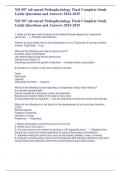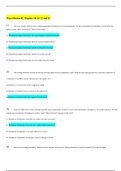NR 507 Advanced Pathophysiology Final Complete Study
Guide Questions and Answers 2024-2025
NR 507 Advanced Pathophysiology Final Complete Study
Guide Questions and Answers 2024-2025
1. What are the two main functions of the kidney Review diagram for anatomical
structures - 1. Filtration and collection
Women are at a higher risk for the development of a UTI because of having a shorter
urethra. True/False - True
Which of the following can help to prevent a UTI?
Increase water consumption
Use spermicides during sexual intercourse
Taking more Vitamin D
Douching to prevent the growth of bacteria - Increase water consumption
A symptom of a lower urinary tract infection includes:
Fever
Flank pain
Urgency
Decreased Urination - Urgency
Which of the following is true regarding a complicated urinary tract infection?
It is usually asymptomatic
Can be caused by a structural urinary tract disorder
Bacteria are located mostly in the lower urinary tract
Is associated with young adults - Can be caused by a structural urinary tract disorder
Which of the following is a risk factor for the development of a urinary tract infection
(UTI)?
Perimenopause
Frequent showering
Marathon running
Pregnancy - Pregnancy
1. Where do bacteria commonly come from in UTI's
2. Where can a UTI occur?
3. It is more common for women to develop a UTI especially when - 1. Bacteria from
the gut can invade the urinary epithelium to cause inflammation and infection
2. anywhere along the urinary tract such as the urethra, bladder, ureter, or kidney
3. pregnant, sexually active, during post-menopause with estrogen-deficiency and when
being treated with antibiotics where the normal bacteria flora is diminished
,NR 507 Advanced Pathophysiology Final Complete Study
Guide Questions and Answers 2024-2025
1. Escherichia coli can bind to cells in the lower urinary tract and hide from the immune
cells. The bacteria can form biofilms-what is this?
2. Describe the pathophysiology of a UTI that can lead to septic shock or bacterimia
Note the diagram btw a male & female urinary tracts (who's is much shorter) - 1. A
biofilm is any group of microorganisms that allow them to stick to one another and
adhere to surfaces that help them survive.
2. First, bacteria enter and contaminate the lower urinary tract. This causes the
colonization of bacteria in the urethra and the bladder. If the UTI progresses the
bacteria can ascend to the kidneys and colonize there. At this point, the infection
becomes an upper UTI. From there, if left untreated, the bacteria can spread into the
circulation via the renal veins causing bacteremia
UTI risk factors
1. For women, pregnancy is a risk factor. why?
2. The female ureter is shorter and
3. Post-menopausal women are also at risk because
4. Sexual intercourse is a risk factor especially if women use
5. Indwelling urinary catheterization is also a major cause of a UTI - 1. During
pregnancy, progesterone relaxes smooth muscle that causes stasis of urine, allowing
the bacteria to colonize
2. allows for the entrance of bacteria into the urethra.
3. lack of estrogen results in vaginal and urethral dryness promoting an environment for
bacteria growth.
4. spermicides
5. Fibrinogen accumulates on the catheter which provides an ideal environment for the
attachment of uropathogens that then form biofilms. This results in epithelial damage
Lower vs. Upper Tract Disorders
1. Lower UTI's include what parts of the urinary tract
2. In a lower urinary tract disorder, the individual experiences (blank) Other common
symptoms include
3. initially, a urine dipstick can be performed to identify hematuria, proteinuria, and the
presence of nitrites. The presence of nitrites
4. an individual can have a negative urine dipstick but still have a UTI. If this is the case,
then the NP can send the urine for a
5. On microscopic exam of the urine, a patient with cystitis will have - 1. urethra
(urethritis) or bladder (cystitis). In males, the cystitis may be associated with prostatitis.
2. urgency associated with burning on urination. frequency, dysuria, and suprapubic
pain. The urine may also appear cloudy and have an odor.
3. is highly specific for bacterial infection
4. culture and sensitivity (C&S) test and microscopy
5. a white blood cell (WBC) count of greater than 5000 high power field (hpf) and
hematuria
,NR 507 Advanced Pathophysiology Final Complete Study
Guide Questions and Answers 2024-2025
1. An infection of the lower urinary tract can progress to an upper urinary tract infection
if the bacteria ascends from the bladder to the kidney. The condition is
2. The signs and symptoms of pyelonephritis include
3. Think of the symptoms of pyelonephritis in a classic triad:
4. if the infection has entered the circulation from the kidney via the renal vein
5. For the patient with pyelonephritis, the urine will present with - 1. pyelonephritis.
2. all the symptoms associated with cystitis plus fever, flank pain, costovertebral angle
(CVA) tenderness, nausea, and vomiting. Malaise is also a common complaint
3. vomiting, flank pain and fever
4. there can also be signs of shock
5. WBC casts
Uncomplicated vs. Complicated Urinary Tract Infections (UTI)
1. A UTI may be classified as complicated or uncomplicated in terms of its severity. An
uncomplicated UTI indicates that
2. In a complicated UTI, there is decreased - 1. renal function is normal, urine results
may confirm a UTI, but the patient denies symptoms, no antibiotic is prescribed
2. renal function and an abnormality in the renal tract
Un-Complicated UTI
1. Occurs in the normal urinary tract
2. Responds well to
3. Ie: Simple cystitis in
Complicated UTI
4. A UTI that extends beyond
5. Caused by
6. Infants and
7. Associated with: - 1. the normal urinary tract
2. a short course of antibiotic therapy
3. non-pregnant women without any urologic abnormalities
4. the bladder
5. structural or functional urinary tract abnormalities or untreated UTI
6. pregnant mothers & older adults affected
7. indwelling catheters, renal calculi, diabetes, pregnancy
1. The most common organisms that cause a UTI is
2. A urinalysis is used to diagnose a UTI. If nitrites are present, this indicates
3. A urine culture may also be performed to determine infection. A positive culture
indicates that there are greater than - 1. Escherichia coli (80% of cases),
Staphylococcus saprophyticus, Proteus Mirabilis, and Klebsiella.
2. the causative organism is gram negative
3. 100,000 colony forming units/ml. remember a UTI occurs when bacteria colonize,
cling to the bladder well, form biofilms and overwhelm the immune system
Using the Urinalysis to Diagnose a Urinary Tract Infection
, NR 507 Advanced Pathophysiology Final Complete Study
Guide Questions and Answers 2024-2025
1. some bacteria are unable to produce nitrites. this would be
2. The presence of nitrites is the most specific finding and has
Differentiate between the UA of a complicated and uncomplicated UTI
Protein
Leukocyte Esterase
Nitrites
RBCs
WBCs
Casts - 1. the case of Enterococcus bacteria
2. the highest positive predictive value.
Complicated
Protein + or -
Leukocyte Esterase +
Nitrites + or -
RBCs +
WBCs + > 100,000/hpf
Casts +
Uncomplicated
Protein + or -
Leukocyte Esterase +
Nitrites + or -
RBCs + or -
WBCs + > 5000/hpf
Casts None
Remember a for a dx of UTI the pt needs to be presenting with symptoms
Casts: are long cylindrical structures formed in the renal tubules due to the precipitation
of Tamm-Horsfall mucoprotein
1. Muddy brown casts suggest
2. Waxy casts are suggestive of
3. Fatty casts are suggestive of
4. RBC casts suggest
5. WBC casts suggest - 1. acute tubular necrosis
2. acute and chronic renal failure.
3. nephrotic syndrome
4. glomerulonephritis
5. interstitial inflammation
RBCs (red blood cells): greater than 3 RBCs/hpf is considered abnormal. Abnormal
morphology of the RBC strongly suggests - glomerular disease.
UTI Prevention, list patient education
1. most important
2. can help to acidify the urine
3. Urinate before and after





